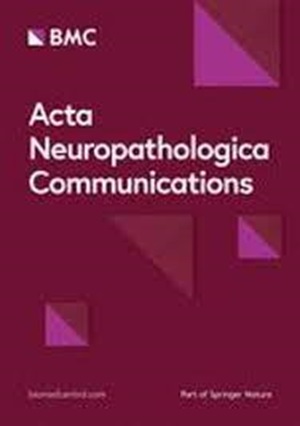评估 Rho 激酶抑制剂在体外视网膜外植体模型中对神经保护和神经炎症的影响
IF 6.2
2区 医学
Q1 NEUROSCIENCES
引用次数: 0
摘要
青光眼是导致失明的主要原因之一,它会影响视网膜神经节细胞(RGC)及其轴突。到 2040 年,可能会有 1.1 亿人受到青光眼的影响。神经炎症,特别是通过 M1 小胶质细胞释放的促炎细胞因子,在青光眼的发展过程中起着至关重要的作用。事实上,在死后人体研究、临床前模型和体外模型中,RGC 的退化一直被证明与炎症反应细胞死亡和组织损伤有关。最近,Rho 激酶抑制剂(ROCKis)已成为治疗神经炎症和神经退行性疾病的潜在疗法。本研究旨在使用体外视网膜外植体模型研究三种 ROCKis(Y-27632、Y-33075 和 H-1152)对视网膜神经节细胞(RGC)丢失和视网膜神经炎症的潜在影响。对大鼠视网膜外植体进行视神经轴突切断术,并用 Y-27632、Y-33075 或 H-1152 治疗。使用免疫荧光和Brn3a特异性标记物评估了对RGC的神经保护作用。通过GFAP、CD68和Iba1染色研究了反应性胶质细胞和小胶质细胞的活化。流式细胞术通过测量用对照溶剂或 Y-33075 处理后 CD11b+、CD68+ 和 CD11b+/CD68+ 细胞的数量来量化第 4 天(DEV 4)小胶质细胞的增殖和 M1 的活化。通过对对照组和 Y-33075 处理过的外植体进行 RNA-seq 分析来测量基因表达的变化,并通过 RT-qPCR 验证神经胶质和促炎细胞因子基因的表达。Y-27632 和 H-1152 并未显著保护 RGC。相比之下,在 DEV 4,50 µM Y-33075 能显著提高 RGC 的存活率。免疫组织学显示,经 Y-33075 处理后,Iba1+/CD68+ 细胞数量减少,星形胶质细胞数量有限。流式细胞术证实,Y-33075 组的 CD11b+、CD68+ 和 CD11b+/CD68+ 细胞数量较少。RNA-seq显示,Y-33075抑制了M1小胶质细胞标志物(Tnfα、Il-1β、Nos2)和胶质细胞标志物(Gfap、Itgam、Cd68)的表达,并减少了细胞凋亡、铁凋亡、炎性体形成、补体激活、TLR通路激活以及P2rx7和Gpr84基因的表达。相反,Y-33075 会上调 RGC 特异性标记物、神经丝形成和神经递质调节因子的表达,这与其神经保护作用相一致。Y-33075具有明显的神经保护和抗炎作用,在防止RGC死亡和减少小胶质细胞炎症反应方面超过了其他测试的ROCKis(Y-27632和H-1152)。这些发现凸显了它作为青光眼治疗选择的潜力。本文章由计算机程序翻译,如有差异,请以英文原文为准。
Evaluation of Rho kinase inhibitor effects on neuroprotection and neuroinflammation in an ex-vivo retinal explant model
Glaucoma is a leading cause of blindness, affecting retinal ganglion cells (RGCs) and their axons. By 2040, it is likely to affect 110 million people. Neuroinflammation, specifically through the release of proinflammatory cytokines by M1 microglial cells, plays a crucial role in glaucoma progression. Indeed, in post-mortem human studies, pre-clinical models, and ex-vivo models, RGC degeneration has been consistently shown to be linked to inflammation in response to cell death and tissue damage. Recently, Rho kinase inhibitors (ROCKis) have emerged as potential therapies for neuroinflammatory and neurodegenerative diseases. This study aimed to investigate the potential effects of three ROCKis (Y-27632, Y-33075, and H-1152) on retinal ganglion cell (RGC) loss and retinal neuroinflammation using an ex-vivo retinal explant model. Rat retinal explants underwent optic nerve axotomy and were treated with Y-27632, Y-33075, or H-1152. The neuroprotective effects on RGCs were evaluated using immunofluorescence and Brn3a-specific markers. Reactive glia and microglial activation were studied by GFAP, CD68, and Iba1 staining. Flow cytometry was used to quantify day ex-vivo 4 (DEV 4) microglial proliferation and M1 activation by measuring the number of CD11b+, CD68+, and CD11b+/CD68+ cells after treatment with control solvent or Y-33075. The modulation of gene expression was measured by RNA-seq analysis on control and Y-33075-treated explants and glial and pro-inflammatory cytokine gene expression was validated by RT-qPCR. Y-27632 and H-1152 did not significantly protect RGCs. By contrast, at DEV 4, 50 µM Y-33075 significantly increased RGC survival. Immunohistology showed a reduced number of Iba1+/CD68+ cells and limited astrogliosis with Y-33075 treatment. Flow cytometry confirmed lower CD11b+, CD68+, and CD11b+/CD68+ cell numbers in the Y-33075 group. RNA-seq showed Y-33075 inhibited the expression of M1 microglial markers (Tnfα, Il-1β, Nos2) and glial markers (Gfap, Itgam, Cd68) and to reduce apoptosis, ferroptosis, inflammasome formation, complement activation, TLR pathway activation, and P2rx7 and Gpr84 gene expression. Conversely, Y-33075 upregulated RGC-specific markers, neurofilament formation, and neurotransmitter regulator expression, consistent with its neuroprotective effects. Y-33075 demonstrates marked neuroprotective and anti-inflammatory effects, surpassing the other tested ROCKis (Y-27632 and H-1152) in preventing RGC death and reducing microglial inflammatory responses. These findings highlight its potential as a therapeutic option for glaucoma.
求助全文
通过发布文献求助,成功后即可免费获取论文全文。
去求助
来源期刊

Acta Neuropathologica Communications
Medicine-Pathology and Forensic Medicine
CiteScore
11.20
自引率
2.80%
发文量
162
审稿时长
8 weeks
期刊介绍:
"Acta Neuropathologica Communications (ANC)" is a peer-reviewed journal that specializes in the rapid publication of research articles focused on the mechanisms underlying neurological diseases. The journal emphasizes the use of molecular, cellular, and morphological techniques applied to experimental or human tissues to investigate the pathogenesis of neurological disorders.
ANC is committed to a fast-track publication process, aiming to publish accepted manuscripts within two months of submission. This expedited timeline is designed to ensure that the latest findings in neuroscience and pathology are disseminated quickly to the scientific community, fostering rapid advancements in the field of neurology and neuroscience. The journal's focus on cutting-edge research and its swift publication schedule make it a valuable resource for researchers, clinicians, and other professionals interested in the study and treatment of neurological conditions.
 求助内容:
求助内容: 应助结果提醒方式:
应助结果提醒方式:


